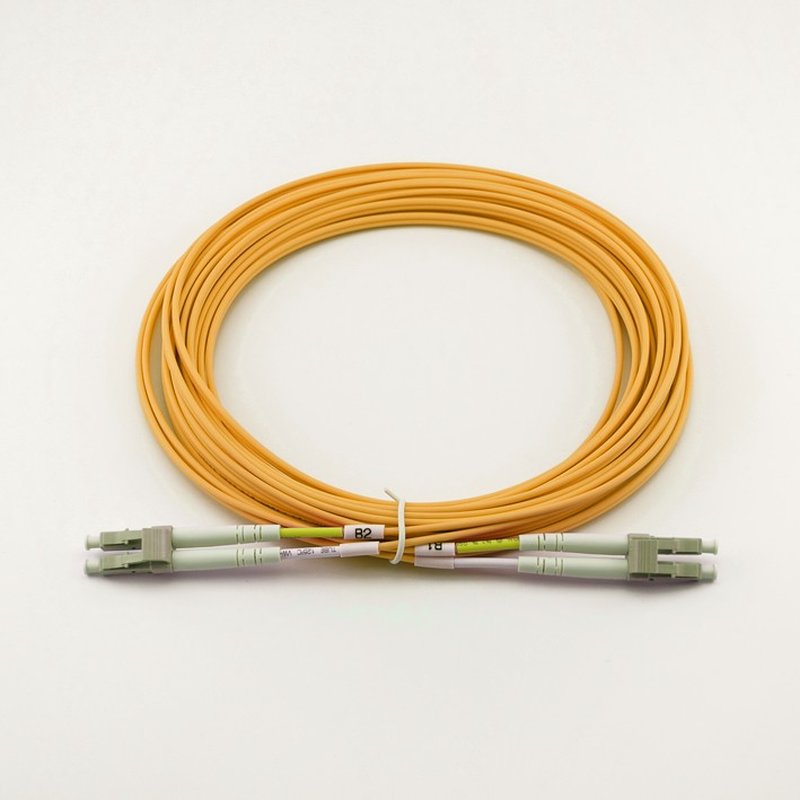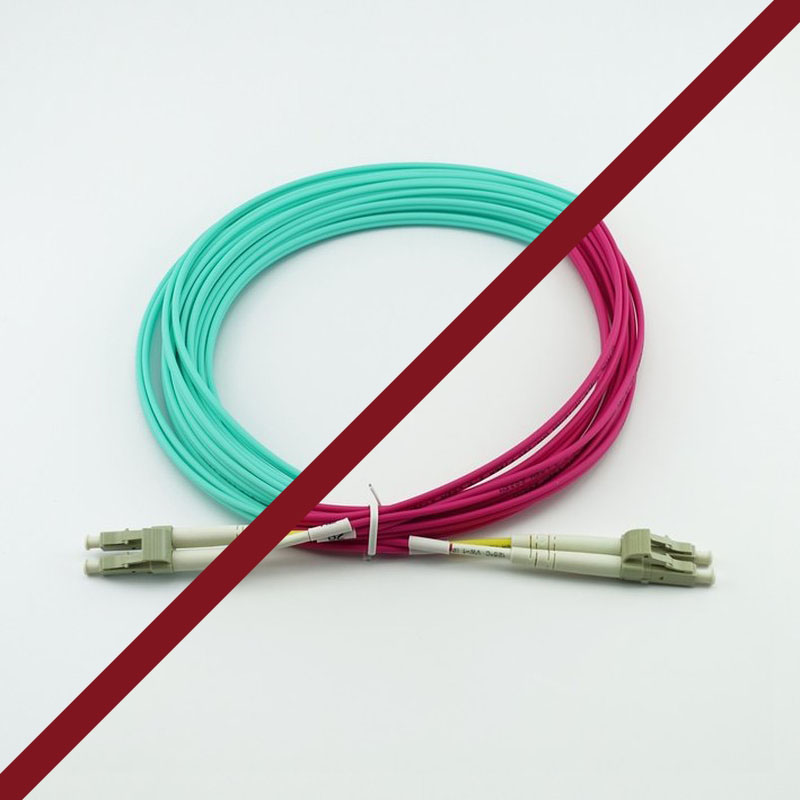OM - is the optical multimode fiber, most commonly used in data centers interconnections. The sequence evolution was like this: OM1, OM2, OM3, OM4 with the latest standard OM5.

OM1 and OM2
OM1 and OM2 where the fibers that supported well the low speeds of up to 1Gbps over medium distances of 300m or 500m for cheap light sources such as LEDs that match very well the relatively large core diameters of the 65 micrometers (OM1) and 50 micrometers (OM2) fibers. As the diffusion of the light source and the core diameter are the limiting factors of an increasing bandwidth over longer distances, these two factors were improved for the next categories of multimode fibers.
OM3 and OM4
OM3 and OM4 fibers are both constructed with a 50μm core diameter and are laser optimized fibers, reducing the spread of the light pulse and thus improving the signal bandwidth and quality. VCSEL - Vertical Cavity Surface Emitting Laser is the cost effective solution for the light source that is used with OM3 and OM4 fibers. There are several advantages to producing VCSELs, in contrast to the production process of edge-emitting lasers. Edge-emitters cannot be tested until the end of the production process. If the edge-emitter does not function properly, whether due to bad contacts or poor material growth quality, the production time and the processing materials have been wasted. VCSELs however, can be tested at several stages throughout the process to check for material quality and processing issues. Even though the VCSEL production process is more labor and material intensive, the yield can be controlled to a more predictable outcome. The larger output aperture of VCSELs, compared to most edge-emitting lasers, produces a lower divergence angle of the output beam, and makes a high coupling efficiency with optical fibers possible.


The high reflectivity mirrors, compared to most edge-emitting lasers, reduce the threshold current of VCSELs, resulting in low power consumption. Newly standardized differential mode delay (DMD) measurement that employed many different laser launches to extract a minimum laser bandwidth classifies fiber that passes the measurement as laser-optimized multimode fiber (LOMMF). The first standard LOMMF offered reliable bandwidth of at least 2000 MHz*km at 850 nm, four times higher than the overfilled bandwidth of OM2. The OM3 opened the age of 10 Gb/s transmission in the early 2000s. By the late 2000s OM4 arrived, offering at least 4700 MHz*km in anticipation of 25 Gb/s per lane applications that have been further developed and delivered to the market as 25G Ethernet (25GBASE-SR), 100G Ethernet (100GBASE-SR4), and 400G Ethernet (400GBASE-SR16). For SANs, Fibre Channel applications track these advancements with 8GFC, 16GFC, 32GFC, and 128GFC (4×32GFC). Today, OM3 and OM4 are the primary fiber media for Ethernet and Fibre Channel applications in data centers.
Channel capacity has been multiplied through the use of parallel transmission over multiple strands of fiber with MPO / MTP. Let’s summarize the above and see what type of combinations are making the optical guides available and the applications range for the fibers.
Table 1: Fiber modes
|
Optical Source |
MultiMode Fiber @ 850nm |
Fiber core diameter (μm) |
Frequency Bandwith |
Summary |
|
LED |
OM1 |
65 |
200 MHz*km |
Low throughput |
|
LED |
OM2 |
50 |
500 MHz*km |
Cheap systems |
|
VCSEL |
OM3 |
50 |
2000 MHz*km |
Cost effective |
|
VCSEL |
OM4 |
50 |
4700 MHz*km |
40G/100G ready |
Table 2: Ethernet applications
|
Distance reach: vs throughput |
OM1 |
OM2 |
OM3 |
OM4 |
|
1G |
300m |
500m |
1km |
1km |
|
10G |
36m |
86m |
300m |
400m |
|
40G / 100G Parallel fibers |
N/A |
N/A |
100m |
150m |
The use of short wave signals in multimode fibers has been an objective to an alliance formed by major players in the industry that have formed the SWDM Alliance. Their mission: “The SWDM Alliance is a collection of companies who believe that the adoption of shortwave wavelength division multiplexing (SWDM) is a cost-effective means of transmitting multiple channels on one duplex multimode fiber pair.” Source: www.swdm.org
 English
English
 Deutsch
Deutsch
 Espaniol
Espaniol










